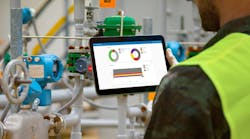Today’s reliability teams have access to a wide array of tools from a vast selection of providers to help streamline their scheduled maintenance routes. From Android and iOS devices to hardened laptops and fit-for-purpose handheld communicators, there’s a plethora of options when heading out into the field to check the health of intelligent field devices.
But what if choosing a tool and going to the field on a regular schedule isn’t the best place to start? As more plants digitally transform their maintenance routines, they discover better ways to manage devices in the field. These plants implement comprehensive device management software in tandem with fit-for-purpose handheld communicators to provide diagnostics, documentation, calibration management and device configuration. As they do so, they also make better use of personnel, freeing them up for more value-added tasks.
Why change tradition?
For many process manufacturing plants, scheduled maintenance rounds were a tradition for decades, and for good reason. Most organizations face some level of industry regulations requiring proof that field devices are functioning properly—particularly with regards to calibration. Even when regulations aren’t an issue, ensuring devices are in proper working order is critical to meeting and documenting operational benchmarks and limiting downtime.
Recently, several things have changed across nearly every industry, shining a new light on this dynamic. First, many plants face worker shortages. For years, the most highly skilled plant technicians have been retiring in droves, a problem that reached critical mass after the COVID-19 pandemic. New workers are hard to find. When they are available, they typically need a lot of training, and they rarely stay in one role for the long tenures common to their predecessors.
When a plant runs a lean staff, sending a person out on scheduled maintenance rounds typically comes at the expense of other work. Equipment repairs, inventory management, new projects and improvements and training quickly get put on the waitlist.
Further complicating matters, plant operators worldwide feel pressure from business leaders to improve performance, while simultaneously meeting increasing expectations for more sustainable operations. Some improvement can come from operational changes, but much of the responsibility falls on reliability teams to ensure equipment is operating efficiently. It requires increased visibility, so teams can track and trend performance, energy use, emissions and more, and these needs will increase as more organizations commit to net-zero goals and require increased carbon accounting. Teams require the right data to make changes and ensure precise performance, along with reliable documentation to support the company’s sustainability efforts, meaning the devices collecting and reporting data must continually operate to specification.
Moving from reactive to proactive
To move away from scheduled rounds, today’s most effective reliability teams implement comprehensive device management software that collects data from wired and wireless sensors. By doing so, they move from a route-based, individual-asset-centric, handwritten methodology to a holistic, software-defined strategy for monitoring and maintaining plant health and configuration.
When a plant’s sensors are tied into an asset management solution, reliability personnel can instantly see the health and configuration of every device in the plant. Instead of waiting for someone in operations to report a problem with a valve or transmitter, maintenance is predictive. The reliability team is immediately notified of impending issues, and troubleshooting can start right away.
With the most advanced systems, the earliest troubleshooting steps can be taken remotely from the device management software. Technicians don’t need to suit up or travel—sometimes into hazardous areas—until they’re certain that a hands-on adjustment is necessary (Figure 1).
A software-defined predictive maintenance strategy offers several additional benefits. Teams no longer need to worry they might miss a problem with a device simply because the technician doesn’t have adequate experience to identify or isolate the issue. Alerts and alarms are compiled into one, highly intuitive dashboard, and this information is provided with actionable advice to help technicians of any experience level begin troubleshooting.
In addition, reliability teams eliminate the risk of missing impending failures due to time intervals between maintenance rounds. If a valve is checked every six months, but begins leaking two days after a scheduled round, the problem will potentially continue for months. Such time lag can have a significant impact on meeting sustainability, emissions and energyuse goals. With device management software, impending problems are typically reported long before a human on scheduled rounds would be able to identify an issue.
When used in tandem with a fit-for-purpose handheld communicator, device management software provides more value. The most advanced handheld communicators offer capabilities to automatically synchronize data collected in the field. Teams no longer need to manually document information gathered on a handheld, and file it with the rest of their collected data. Instead, when a user connects a fit-for-purpose communicator to the device management software, it automatically uploads all data, ensuring information is always up-to-date, transcription errors are eliminated, and stranded devices are displayed with other devices on the dashboard.
Streamlining calibration
A key benefit of moving to a device management system is simpler and easier device calibration in the field. While the device management software doesn’t perform calibration, the systems can schedule regular calibration to ensure it’s not missed. Moreover, the most advanced device management solutions can define calibration activities before technicians go to the field, and send those procedures to the calibrator. Once the technician performs the calibration, all the results are stored in the calibrator, and can be quickly and easily uploaded to the device management software when the user returns.
One of the key benefits of this easy synchronization of calibration data is reliability teams can track and trend the performance of devices. Instead of simply performing a calibration, writing down the results, and putting them in a filing cabinet in case of an audit, the team can monitor how device performance changes over time on their software dashboard, and use that information to better schedule calibration procedures. Instead of running a specific calibration schedule, teams can schedule based on trends. For example, if calibration records show a device isn’t drifting, it could be calibrated every 12 months instead of every six months. Across hundreds or thousands of devices, that small change can save a great deal of time.
Driving an efficient and sustainable future
Without a deep bench of personnel to support time-consuming, low-value data collection tasks, teams must find ways to work as efficiently as possible—especially in the face of increasing expectations for more productive and sustainable operation. Device management software coupled with fit-for-purpose handheld communicators can close that gap, helping teams reduce or eliminate time spent traveling into the field for data collection, configuration and calibration efforts. Moreover, teams can view more data, empowering them to predict failures before they impact operations, and drive more efficiency and sustainability. In coming years, as plants try to meet business objectives, those differentiators could be leading indicators of a plant’s overall success.





